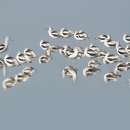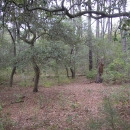About Us
The 110,000-acre Pocosin Lakes National Wildlife Refuge conserves a rare type of wetland habitat, known as "pocosin," derived from a Native American word meaning "swamp on a hill." In 1963, Pungo NWR was established for the protection of waterfowl and other migratory birds. In 1990, Pocosin Lakes NWR was established to protect migratory birds and the unique pocosin wetlands, and Pungo NWR became the Pungo Unit of Pocosin Lakes NWR. The refuge encompasses vast acres of natural wetlands, including the unique southeastern pocosin peat wetlands; open water on Pungo and New Lakes; upland pine forests; and waterfowl impoundments managed for moist soil wetlands and agricultural units that provide high-energy food for migrating and wintering waterfowl. More than a hundred thousand ducks, geese, and swans congregate on the refuge in winter, and the refuge supports one of the densest populations of black bear ever reported.
The refuge is the site of one of the country’s largest wetland restoration projects, restoring natural hydrology to the pocosin peatlands. Before the refuge was established, many acres of this wetland were drained, greatly increasing the risk of ground fire. To the greatest extent possible, the refuge is restoring the natural conditions of a healthy pocosin ecosystem. These restored pocosin peatlands provide habitat for endangered species including red wolf (Canis rufus) and red-cockaded woodpecker (Picoides borealis), as well as many other species of wildlife.
Pocosin Lakes NWR is proud to have been recognized as a Wetland Treasure by the Carolina Wetlands Association in 2020. We continue to work with the Carolina Wetlands Association and other partners to promote wetland protection and wetland value that will benefit wetlands across the Carolinas.
Our Mission
Vision
The Pocosin Lakes National Wildlife Refuge will restore and maintain natural processes and biodiversity of a functional pocosin wetland and provide habitat for threatened, endangered, and other Federal trust species. On the Pungo Unit, the refuge will provide optimum wintering habitat for migratory waterfowl and breeding habitat for wood ducks throughout the refuge on suitable habitats in conjunction with other refuges in the National Wildlife Refuge System.
The refuge will reduce habitat fragmentation by establishing corridors to other protected areas in the central Albemarle-Pamlico Peninsula. The visitor center will be a gateway for visitors to refuges in eastern North Carolina. The refuge will serve as a destination for nature-based tourism that will contribute to the economic health of rural communities. It will provide opportunities for priority public uses. The refuge staff will continue to use partnerships to accomplish goals.
Refuge Purpose(s)
Each unit of the National Wildlife Refuge System is established to serve a statutory purpose that targets the conservation of native species dependent on its lands and waters. All activities on those acres are reviewed for compatibility with this statutory purpose.
The purposes of Pocosin Lakes NWR, including the Pungo Unit, as reflected in the legislation under which Congress authorized the refuge and the refuge has acquired land, is to protect and conserve migratory birds and other wildlife resources through the protection of wetlands, in accordance with the following laws:
“...for use as an inviolate sanctuary, or for any other management purpose, for migratory birds...” 16 U.S.C. Sec. 715d (Migratory Bird Conservation Act of 1929);
“...for the conservation of the wetlands of the Nation in order to maintain the public benefits they provide and to help fulfill international obligations contained in various migratory bird treaties and conventions...” 16 U.S.C. Sec 3901 (b) 100 Stat. 3583 (Emergency Wetland Resources Act of 1986)
“...for the development, advancement, management, conservation, and protection of fish and wildlife resources...” 16 U.S.C. Sec 742f(a)(4) (Fish and Wildlife Act of 1956)
“...for the benefit of the United States Fish and Wildlife Service in performing its activities and services. Such acceptance may be subject to the terms of any restriction or affirmative covenant or condition of servitude...” 16 U.S.C. Sec 742f(a)(4) (Fish and Wildlife Act of 1956)
Other Facilities in this Complex
The refuge is managed as part of the Coastal North Carolina National Wildlife Refuge Complex. A National Wildlife Refuge Complex is an administrative grouping of two or more refuges, wildlife management areas or other refuge conservation areas that are primarily managed from a central office location. Refuges are grouped into a complex structure because they occur in a similar ecological region, such as a watershed or specific habitat type, and have a related purpose and management needs.
There are 9 national wildlife refuges in the Coastal North Carolina National Wildlife Refuges Complex. The Project Leader for the Complex supervises the Refuge Managers who are responsible for managing these refuges. However, there are five distinct and separate administrative offices. Alligator River and Pea Island National Wildlife Refuges are administered from the Alligator River National Wildlife Refuge Headquarters in Manteo, NC. An administrative office at the Mackay Island National Wildlife Refuge Headquarters in Knotts Island, NC manages both Mackay Island and Currituck National Wildlife Refuges. An office at Mattamuskeet National Wildlife Refuge administers Mattamuskeet, Swanquarter, and Cedar Island National Wildlife Refuges. Pocosin Lakes National Wildlife Refuge, Roanoke River National Wildlife Refuge, Great Dismal Swamp National Wildlife Refuge, Back Bay National Wildlife Refuge, and Edenton National Fish Hatchery each have separate administrative offices.
All of the Coastal North Carolina National Wildlife Refuges, Great Dismal Swamp National Wildlife Refuge, Back Bay National Wildlife Refuge, and Edenton National Fish Hatchery are open to public visits for nature-based recreational enjoyment. Priority public uses are hunting, fishing, wildlife observation, wildlife photography, environmental education, and interpretation.






